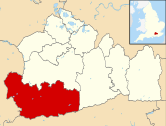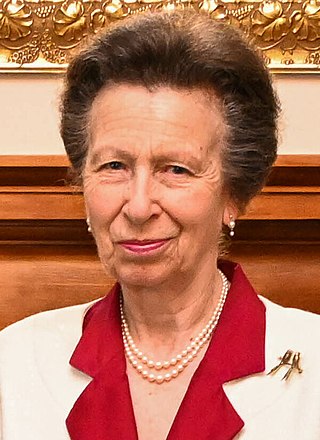
Anne, Princess Royal is a member of the British royal family. She is the second child and only daughter of Queen Elizabeth II and Prince Philip, Duke of Edinburgh, and the only sister of King Charles III. Anne was born 3rd in the line of succession to the British throne and is now 17th, and has been, since 1987, Princess Royal, a title held for life.

Princess Benedikte of Denmark, Dowager Princess of Sayn-Wittgenstein-Berleburg is a member of the Danish royal family. She is the second daughter and child of King Frederik IX and Queen Ingrid of Denmark. She is the younger sister of Queen Margrethe II of Denmark, and therefore the aunt of Margrethe's son, the current King of Denmark, Frederik X. She is also an older sister of Queen Anne-Marie of Greece.
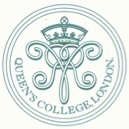
Queen's College is a private day school for girls aged 11–18 with an adjoining prep school for girls aged 4–11 located in the City of Westminster, London. It was founded in 1848 by theologian and social reformer Frederick Denison Maurice along with a committee of patrons. In 1853, it was the first girls' school to be granted a Royal Charter for the furtherance of women's education. Ever since, the college patron has been a British queen.
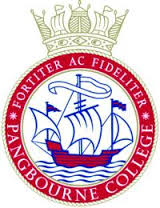
Pangbourne College is a co-educational private day and boarding school located in Pangbourne, Berkshire. It is set in 230 acres, on a hill south-west of the village, in an Area of Outstanding Natural Beauty.

Benenden School is an independent boarding school for girls in Kent, England, in Hemsted Park at Benenden, between Cranbrook and Tenterden. Benenden has a boarding population of over 550 girls aged 11 to 18, as well as a limited number of day student spaces.
PHC was a co-educational independent day and boarding school for students aged 11 to 18 in Preston near Hitchin in Hertfordshire, England.

St Catherine's School is an independent girls' boarding and day school in the village of Bramley, near Guildford, Surrey, England. The school is divided into a senior school, for ages 11–18, and a preparatory school for girls aged 4–11.

Queen Victoria School (QVS) is a non-selective, co-educational, boarding school predominantly for children of Scottish Servicemen/women (but see full admissions criteria, below) aged 10/11 to 18. It occupies a Scottish Baronial-style building on a rural campus just outside Dunblane, a short distance away from the city of Stirling, Scotland. It is the only school in the United Kingdom managed and funded by the Ministry of Defence (Duke of York's Royal Military School in Kent is now managed by the DfE).

Jeanne Louise Henriette Campan was a French educator, writer and Lady's maid. In the service of Marie Antoinette before and during the French Revolution, she was afterwards headmistress of the first Maison d'éducation de la Légion d'honneur, appointed by Napoleon in 1807 to promote the education of girls.

The Royal Hospital School is a British co-educational fee-charging boarding and day school with naval traditions. The school admits pupils from age 11 to 18 through Common Entrance or the school's own exam. The school is regulated by Acts of Parliament.

The Royal Naval School was an English school that was established in Camberwell, London, in 1833 and then formally constituted by the Royal Naval College Act 1840. It was a charitable institution, established as a boarding school for the sons of officers in the Royal Navy and Royal Marines. Many of its pupils achieved prominence in military and diplomatic service. The school closed in 1910.

The Grey Coat Hospital is a Church of England secondary school with academy status for girls in Westminster, London, England. In 2013, it had 1064 pupils including 40 boys in the Sixth Form. It is a specialist Language College.
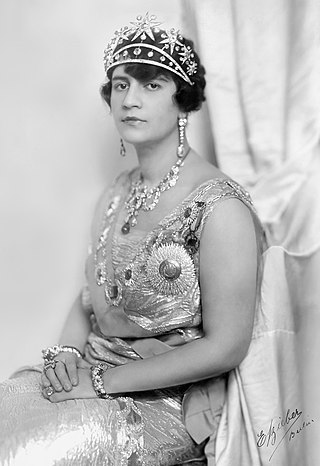
Soraya Tarzi was the first queen consort of Afghanistan as the wife of King Amanullah Khan. She played a major part in the modernization reforms of Amanullah Khan, particularly in regard to the emancipation of women.

Emanuel School is a private, co-educational day school in Battersea, south-west London. The school was founded in 1594 by Anne Sackville, Lady Dacre and Queen Elizabeth I and today occupies a 12-acre site close to Clapham Junction railway station.

This article gives brief information on schools that cater for pupils up to the age of 11 in the Dacorum district of Hertfordshire, England. Most are county maintained primary schools, sometimes known as "junior mixed infant" (JMI). A small number are voluntary aided church schools or independent (fee-paying). The Local Education Authority is Hertfordshire County Council.

The Royal School for Daughters of Officers of the Army was a girls' boarding school situated in Bath, England. In 1998 it was incorporated into the Royal High School.
Olive Margaret Willis was an English educationist and headmistress. She founded Downe House School and was its head for nearly forty years, from 1907 to 1946.
The Royal School, Hampstead, was an independent girls' day and boarding school located in Hampstead, London, England. The school was founded in 1855 by Queen Victoria and for 157 years educated girls aged 3–18. The school had 2 longstanding royal patrons: the first was Queen Victoria for 70 years, and the second Princess Alexandra who retired in 2005 after 50 years of service. The succeeding patron was Camilla, Duchess of Cornwall. In 2011, the school merged with North Bridge House School at the end of the academic year (2011/12) under the management of Cognita.

The wedding of Princess Elizabeth and Sir Philip Mountbatten took place on Thursday 20 November 1947 at Westminster Abbey in London, United Kingdom. The bride was the elder daughter of King George VI and Queen Elizabeth as well as the heir presumptive to the British throne. The groom was born a Greek and Danish prince; he stopped using these foreign titles on his adoption of British nationality four months before the announcement of their marriage and was made Duke of Edinburgh, Earl of Merioneth and Baron Greenwich on the morning of the wedding.
Emmeline Maria Kingdon was an English headmistress of the Royal School for Daughters of Officers of the Army in Bath.


















